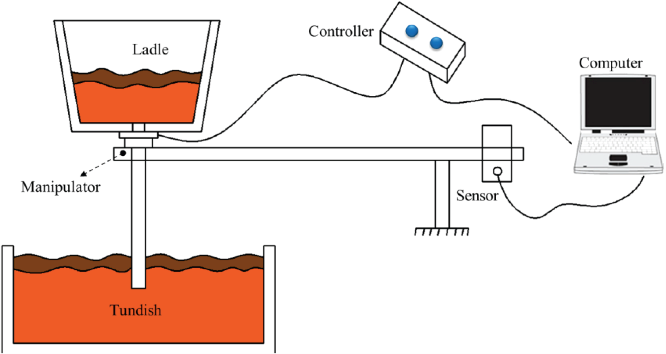Ladle slag detection is important for continuous casting operation and product quality because of the following reasons:
· Increase the purity of molten steel by eliminating further inclusion formation.
· Improve the quality of billet/slab.
· Decrease the erosion of refractory in the tundish.
· Improve the productivity of continuous casting.
· Decrease the labour intensity as far as deskulling is concerned.
· Better efficiency compared to manual visualization and sensing technique.
· Increase life of tundish slide gate plates and ladle shroud.
When the load cell placed on the turret signals that only 5–10 tons of steel weight is left in the ladle, the operator simply grabs the shroud manipulator and feels for the vibration and decides when to cut off the flow. Humans are notably sensitive to vibration acceleration levels and may notice acceleration as low as 0.01 m/s2 at 5 Hz.
Techniques have been developed to detect the slag carry-over from the ladle, such as electromagnetic methods, weight monitoring technique, optical methods and supersonic detection. Among them, electromagnetic detection is the most widely used technique because of its superior accuracy and response sensitivity.
Some combine the measurement of vibration signals close to the ladle with long-wave infrared (LWIR) imaging and cite exponentially filtered fast-fourier transform (FFT) as the base method to extract information from the system. Others incorporate accelerometer measurements with near-infrared imaging to extract data through the frequency-domain using FFT. Whereas, some analyze the ladle vibration information by multiple algorithms, including time- and frequency domain and wavelet transformation.
Some crucial issues are challenging the application of electromagnetic method which includes high manufacture and maintenance cost, complex installation and short service life.
A promising alternative is monitoring the different vibration signals caused by the different densities between steel and slag. When there is slag entrainment, the vibration amplitude decreases. This indirect detecting method has several advantages 1) it can realize prior detection for the slag carry-over for the funnel vortex, 2) the indirect detection on the manipulator allows long service life; 3) simple mechanical structure and low cost.
The flow from ladle to tundish can be:
1. Full Liquid Steel flow
2. Slag Entrapment flow (Slag float on the surface of liquid steel in the ladle. When vortex is formed in the ladle, the slag which floats on the vortex center will enter into shroud along with liquid steel).
3. Slag- Liquid Steel mix flow.
4. Full Slag flow.
The vibration of the shroud pipe is transferred to the manipulating beam and the shroud is vibrating because of the flow of the molten steel. The molten steel flows with high velocity through the shroud pipe, resulting in fully turbulent behavior. At a certain point, as the layer of molten steel below the slag cover starts to disappear, the character of the flow will become more laminar; causing reduced vibration levels.
A sensor is installed on the manipulator to detect the vibration energy.
The sensor serves few purposes like acquiring the signal from the X, Y, Z in three directions. The signal is then amplified and sent to the instrument. This design utilizes the resonance principle, the inherent frequency of the device could be adjusted close to the special slag frequency to generate resonance when slag flow into the shroud, so as to amplify the valid vibration signal. It also could filter out other frequency interference and noise.
It adopts a Wavelet Analysis Algorithm that could judge the different flow status and give slag alarm on time before they enter into the tundish.
The vibration acceleration data is analyzed by a cumulative sum (CUSUM) control chart in real-time, providing a violation signal that can be used to close the ladle outflow valve.
The caster, turret, ladle, and other components are supported by a multi-floor steel structure; vibration may result from the movement of cranes, turret, cast oscillators, rollers, etc. Microelectromechanical (MEMS) acceleration sensor mounted on the surface of the manipulator beam halfway between the end of the arm and the supporting joint, helps to maximize vibration levels.
This three-axis accelerometer, having a 14-bit analog to digital converter (ADC), which has most sensitive setting of ± 2 g and communicates with a microcontroller unit (MCU) using the I2C bus. The MCU reads the accelerometer data in all three axes at regular fs =200 Hz sampling intervals ensured by a hardware peripheral timer and then transfers it through a serial port for data logging into a personal computer. Acceleration is shown for the Z-axis that is perpendicular to the boom axis (and partially the casting floor).
The z-axis acceleration of the shroud pipe manipulator arm is sampled with a period of T seconds. Instead of working with the acceleration data directly, the root square of the approximate derivative is computed by

The derivative of acceleration with respect to time is a good indicator of the vibration energy and is commonly known as a jerk. The aim of the algorithm is not to compute the percentage slag content of the ladle outflow, but to establish the time when the slag content is critical (most of the liquid material is slag).



